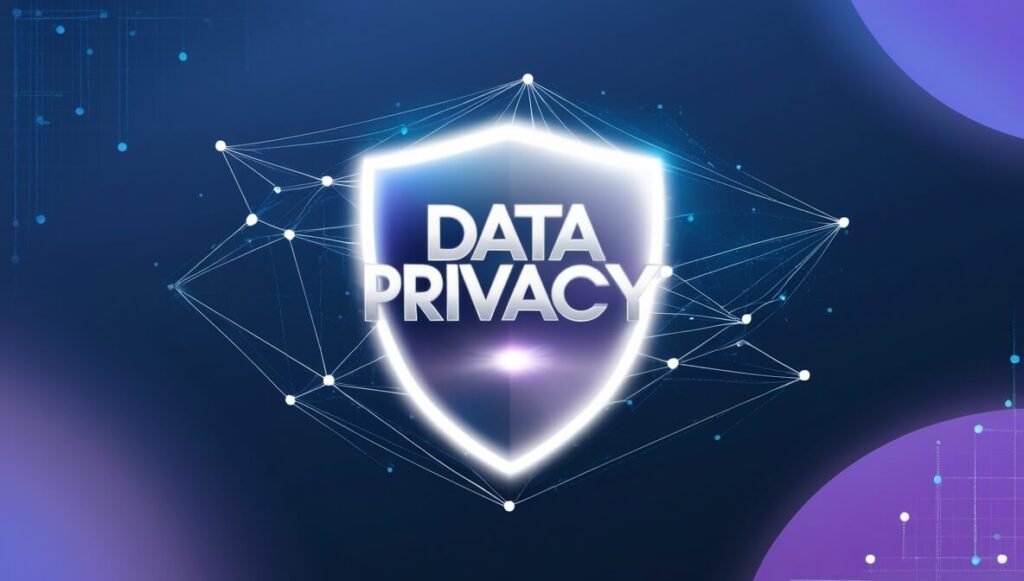Digitalization done, the common issue of data privacy has turned out to be a major headache for individuals, businesses, and governments who are already on the lookout for effective answers to the problem. Data breaches and cyberattacks are everywhere, which makes the secure storage and sharing of information more necessary than ever. However, blockchain technology is seen as a real game-changer in the distrust of cryptocurrencies and privacy technology which is undoubtedly its major advantage. This post focuses on the point where blockchain and data confidentiality meet, considering their effects, advantages, limitations, and outlook.
Blockchain is a technology requiring a distributed ledger for data recording. The ledger is decentralized and distributed and is a critically important technology associated with the cryptocurrency industry. Each block contains a number of transactions, and as it is recorded it cannot be altered without the network’s agreement, making the blocks immutable. The distinct nature of blockchain data management systems removes them from the transparency and trust deficits of the traditional data management systems and thus, cannot be tempered with.
Key Features of Blockchain
- Decentralization: Blockchains are a network that uses nodes rather than a traditional database that usually has a central authority to manage it. This leads to bringing down the risk of single points of failure as well as lessens the chances of data tampering.
- Immutability: Data written on the blockchain is close to being impossible to change. This feature ensures the data’s integrity.
- Transparency: Blockchain ensures a high level of transparency without sacrificing user privacy. Although all transactions can be seen on the network, no one can distinguish who the participants are.
- The use of cryptographic security ensures that transactions and data are protected with the help of cryptographic algorithms, as a result only authorized personnel get a chance to access them. This strict barrier hinders potential unauthorized users’ access to information and, therefore, guarantees data manipulation.
Data Privacy in The Digital Age
In this day and age of digital technology, personal data is so valuable that keeping it safe is sometimes harder than climbing the Everest.
Theft of data, unapproved sharing, and misuse of personal information have aroused anxiety over data privacy. General Data Protection Regulation (GDPR) and California Consumer Privacy Act (CCPA) are ways that came into being in response to these threats to people’s rights to privacy, and their personal data protection.

How Blockchain Enhances Data Privacy
1. Greater Control Over Personal Data
The biggest advantage of blockchain technology is the superior control that it gives the users over their own data. In the usual method, the data is frequently located in central databases that are run by third parties, these databases are easily subject to hacking and illicit uses.
Meanwhile, blockchain technology makes it possible for the data owner to always stay the owner of his/her information. The “self-sovereign identity” (SSI) conception is followed by the individuals to demonstrate their digital identities without the intermediation of centralized authorities. The control level they have is the option of the data that they want to share with other people, and with whom, and for how long. This progression opens up a new era in the digital domain of data privacy, whereby users are in direct control of what they share.
2. Anonymity and Pseudonymity
Blockchain technology enables anonymity on a spectrum of levels. Just an example, the identities of the actors involved in public blockchain transactions, such as Bitcoin, are pseusonymous — the wallet address stems first on the chain and hides the real identity of the person. This, however, lets the identifier to be linked to the transaction data. An example of that happening is if the actor’s real name is revealed.
Private or permissioned blockchains can give more privacy while also removing the ability of passive parties to access certain transaction detail. Such decentralized processes help people to verify and secure their identity in a way that is still connected to the rest of the users. As a result, it still simplifies the management for the contractors.
3. Secure Data Sharing
The main issue with traditional ways of data exchange is the possibility of privacy breaches, especially when sensitive data is being passed between different organizations. With a blockchain-based system in which the ledger is spread among many computers and is not in one place, secure data sharing is possible.
Smart contracts, i.e. self-executing contracts that run the terms directly from the code, can set up checks for qualifications of the data sharing clients. For example, connected companies can run smart contracts that demand individuals obtain specified permissions in order to see or alter the personal information.
4. Audit Trails and Accountability
The timestamp of every transaction is recorded and it is based on the fact that the transaction cannot be altered. The main purpose of the audit trail is to get a comprehensive list of the relevant data, which is in turn used to ensure compliance with data protection regulations. Companies can show responsibility and honesty in regard to personal data through audits, and this would considerably decrease the likelihood of penalties resulting from non-conformity.
Challenges of Blockchain and Data Privacy
1. Regulatory Concerns
Apart from vibrant solutions, blockchain is also provoking regulatory difficulties on the Data Protection and Privacy front. Are there any implementations of blockchain that are compliant with the present EU laws on the right to privacy, e.g., the GDPR laws? All of these laws comprise some of the characteristics of these ones, for example, the “right to be forgotten” asks for organizations to delete personal information upon demand. Nevertheless, owing to the immutable quality of blockchain, data cannot just be easily erased.
Several remedies have been suggested including putting important information out of the blockchain together with the process of validation still being done in the chain. However, the single stumbling element which needs to be overcome is the compliance with the essential requirements and the inherent qualities of blockchain technology.
2. Data Breaches and Network Vulnerabilities
Blockchain is generally very secure as a technology platform, although its applications may still suffer from vulnerabilities. An example of this is when a hacker takes over a user’s private keys and uses them to unlock the user’s data and complete transactions. Hence, the security to which blockchain applications are subjected is vital to privacy of information.
3. Scalability Issues
Scaled instances of blockchain technologies cannot possibly perform as fast and as high due to its characteristics and issues, especially in public forms. The greater the network becomes, the more hard it is for it to handle a lot of transactions and synchronization of data. These problems entail the efficiency of many real-life applications of blockchain, the examples of which are industries which need immediate handling of data.
The Future of Blockchain and Data Privacy
As blockchain tech advances and becomes more mainstays of data privacy issues, the possible uses for data protection are ever-broadening. zSLARKs (zero-knowledge succinct non-interactive arguments of knowledge) is one innovation that could potentially bring even more privacy to public blockchains. These never-before-seen tools could allow users to give proof about the data they have without really letting the information be known.
Some of the forthcoming trends such as the involvement of artificial intelligence (AI) and blockchain will also be among the key driving forces in the enhancement of data privacy. AI can use groove technology to read the patterns of the chains to detect anomalies or any unauthorized access, which in turn, can secure the information in a better way.
Blockchain technology has new ideas to tackle personal data privacy problems in the digital age. By endowing citizens with the right to self-possess their private data, providing secure methods of transfer, and setting up a clear outline of audit lines that everyone can see, blockchain can solve many privacy issues. However, just like with every other technology, challenges still persist, concentrating mostly on regulatory compliance, cybersecurity, and scalability. Through continued research and development, the blockchain and data privacy will surely be related together and secure and protect the integrity of data. Easy-to-understand examples will be a very enlightening experience for many individuals. In the near future the already existing technology will be used very widely. People will not cyberattack but will also find the program that suits them best. Just as the internet has been a game-changer for the way we talk to one another and organize businesses, blockchain has the power to revolutionize data privacy, making a situation where people feel safe and assured in the digital world.

